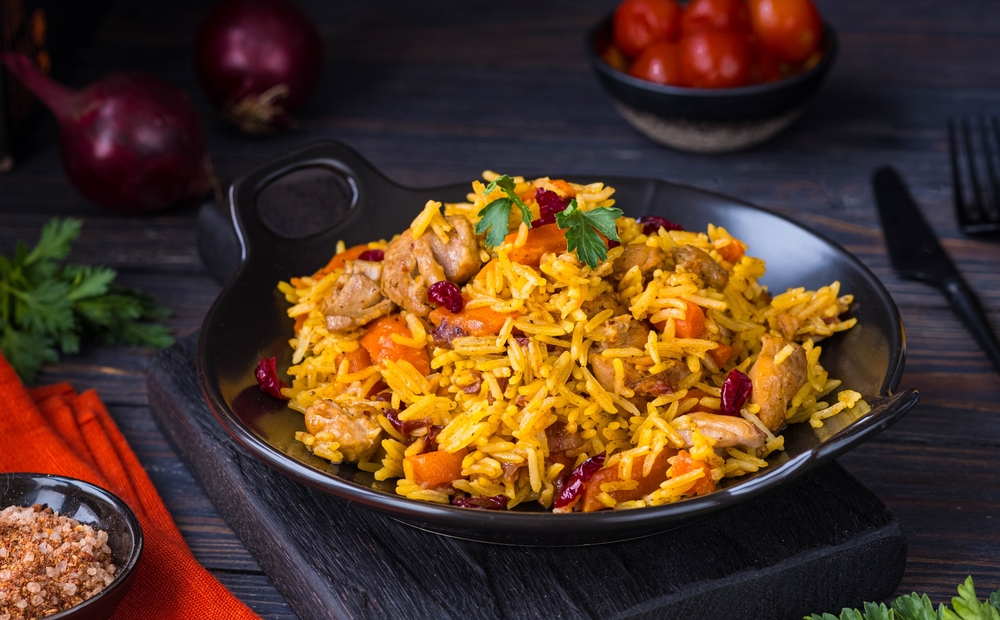Pilau, a fragrant rice dish, is a culinary gem that sparkles in the gastronomy of Tanzania. While its origins trace back to the Indian subcontinent and the Middle East, Pilau has been embraced, adapted, and made distinctly Tanzanian by integrating local flavors and cooking traditions. A celebration dish, Pilau is often associated with festivities, communal gatherings, and special occasions in Tanzania.
Tracing the Origins of Pilau in Tanzania
Tanzania’s coastal region has been a melting pot of cultures due to its strategic location along trade routes. Through centuries of trade, colonization, and migration, a medley of spices, flavors, and culinary techniques merged. The influence of Indian and Arabian traders brought Pilau to the Tanzanian coast, where it was soon incorporated into local culinary traditions.
Swahili culture, predominant on the Tanzanian coast, embraced Pilau, marrying it with the rich tapestry of local spices available. Today, it stands as a testament to Tanzania’s rich cultural mosaic, loved by locals and tourists alike.
Essential Ingredients for Tanzanian Pilau
- 2 cups of basmati rice
- 4 cups of water or broth (chicken or beef)
- 1 large onion, finely sliced
- 2-3 cloves of garlic, minced
- 1 inch of ginger, minced
- 1 tsp cumin seeds
- 1 tsp cardamom pods
- 1 cinnamon stick
- 3-4 cloves
- 1/2 tsp black pepper
- 2 tbsp cooking oil or ghee
- Salt to taste
- Optional: Meat (chicken, beef, or mutton) cut into pieces, and assorted vegetables like potatoes or peas.
Step-by-Step Cooking Instructions
- Preparation: Wash the rice thoroughly and soak it for about 30 minutes. Drain the water and set aside.
- Spice Infusion: In a large pot or saucepan, heat the cooking oil or ghee over medium heat. Add cumin seeds, cardamom pods, cloves, and cinnamon stick. Fry for a minute until aromatic.
- Sautéing: Add the sliced onions and sauté until they turn golden brown. Add garlic and ginger, continuing to sauté until fragrant.
- Meat and Vegetables: If you’re using meat, add it to the pot now and brown on all sides. If using potatoes or other vegetables, add them after the meat has browned and cook for a few more minutes.
- Rice Incorporation: Add the drained rice to the pot, stirring gently to coat it with the spices and oil.
- Cooking: Pour in the water or broth. Season with salt and black pepper. Bring it to a boil, then reduce the heat to low, cover the pot, and let it simmer until the rice is cooked and all the liquid is absorbed.
- Serving: Once cooked, fluff the Pilau with a fork. Serve hot, often accompanied by a side of Kachumbari (East African salsa) or a refreshing yogurt sauce.

Embracing the Full Pilau Experience from Tanzania
Enjoying Pilau in Tanzania is not just about savoring a dish—it’s about celebrating the rich history, cultural exchanges, and the tapestry of flavors that the country offers. Each bite tells a story of trade routes, cultural interactions, and the love Tanzanians have for their food. Whether at a wedding, a family gathering, or an ordinary day made special, Pilau is a taste of Tanzanian hospitality and heritage.
Venture into Tanzanian Gastronomy
Unravel the myriad flavors of Tanzania, a nation where each dish narrates a unique tale. From the sun-kissed plains of Serengeti to the azure coastlines of Zanzibar, Tanzania’s culinary offerings are a reflection of its diverse landscapes and cultures. As you savor these dishes, don’t stop there. Dive deeper into the world of Tanzanian cuisine with our comprehensive hub. Discover recipes, lore, and the little-known secrets that shape this cuisine. Join us on this flavor-packed journey and celebrate the culinary marvels of Tanzania in all their glory. Experience, experiment, and expand your horizons, one dish at a time!
